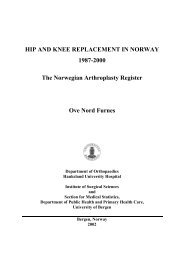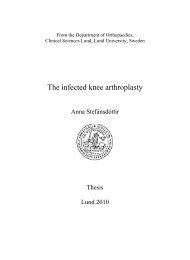E-Book German Arthroplasty Register EPRD - EAR - EFORT
E-Book German Arthroplasty Register EPRD - EAR - EFORT
E-Book German Arthroplasty Register EPRD - EAR - EFORT
Create successful ePaper yourself
Turn your PDF publications into a flip-book with our unique Google optimized e-Paper software.
14<br />
The <strong>German</strong><br />
<strong>Arthroplasty</strong> <strong>Register</strong><br />
(<strong>EPRD</strong>)<br />
Even though, according to<br />
the criteria of evidence-based<br />
6. Discussion and Outlook<br />
medicine, randomised controlled<br />
studies are considered to<br />
have the highest scientific value, they are not suited for<br />
analysis of the results of nationwide arthroplasty treatment<br />
in <strong>German</strong>y (20). After all randomised controlled<br />
studies, at great expense, are aimed at comparatively<br />
analysing selected, different therapeutic procedures.<br />
Thus, a randomised controlled clinical trial is not a suitable<br />
instrument to describe or analyse the comprehensive<br />
and long-term quality of treatments as achieved in<br />
routine patient care (10;21).<br />
In this context <strong>Register</strong> data provide a sound basis for<br />
highly representative comparative evaluations using<br />
Comparative Effectiveness Research (CER) (10;22). <strong>Register</strong><br />
data and results from controlled clinical trials are<br />
complementary ways to obtain conclusive evidence of<br />
outcome quality in arthroplasty; they do not compete<br />
but sensibly complement each other.<br />
The <strong>Register</strong> data obtained are evaluated for epidemiological<br />
and clinical research projects, to provide support<br />
and advice in innovative products development, as well<br />
as to enhance transparency in the presentation of outcome<br />
quality in arthroplasty.<br />
Direct feedback to the <strong>Register</strong> participants should help<br />
reduce the revision rate of implants. Early indications of<br />
irregularities are identified through statistical process<br />
control of the results so as to trigger off an early warning<br />
mechanism in a systematically graduated procedure if<br />
necessary. In the case of severe irregularities the responsible<br />
bodies and project partners may use <strong>Register</strong> data<br />
– in accordance with strict rules – to inform the patients<br />
concerned, provided the patients have previously complied<br />
with the transfer of their data.<br />
In interpreting the variance in implant survival times<br />
one must discern whether the irregularities observed<br />
are related to treatment or implant-associated problems.<br />
Structure, Procedures and Organisation<br />
Apart from the reasons of revision queried,<br />
conclusions can, for example, also be drawn<br />
from the geographic distribution pattern of<br />
the revisions observed.<br />
Data analysis is published at regular intervals.<br />
Thus, patients will be informed about<br />
the quality of health care; health insurance<br />
providers will have transparent information<br />
available about the quality of treatment;<br />
health care providers will have a comparative<br />
value for benchmarking their own<br />
quality; scientific societies will be provided<br />
with basic information to assess the performance<br />
of new techniques, new implants<br />
and new areas of application and enabling<br />
them to give support and advice during the<br />
innovation process; policy-makers and the<br />
BfArM [Bundesinstitut für Arzneimittel und<br />
Medizinprodukte – Federal Institute for Drugs<br />
and Medical Devices; translator’s note] will<br />
be able to rely on largely comprehensive<br />
records as regards long-term quality; and<br />
manufacturers finally, in terms of an early<br />
warning system, will receive early feedback<br />
about potential problems, innovation risks<br />
and shortcomings in results, as well as data<br />
on the outcome quality of their products.<br />
From an international perspective, the data<br />
of the <strong>German</strong> <strong>Arthroplasty</strong> <strong>Register</strong> will<br />
form the basis for a long-term target: the<br />
participation in a European Joint Replacement<br />
<strong>Register</strong>, which is currently at the<br />
planning stage. The Minimal Dataset proposals<br />
for primary and revision hip and knee<br />
arthroplasty as previously published by the<br />
European <strong>Arthroplasty</strong> <strong>Register</strong> have been<br />
taken into account in their entirety (23-26),<br />
enabling the <strong>EPRD</strong> to make its full contribution<br />
to the common European project.









